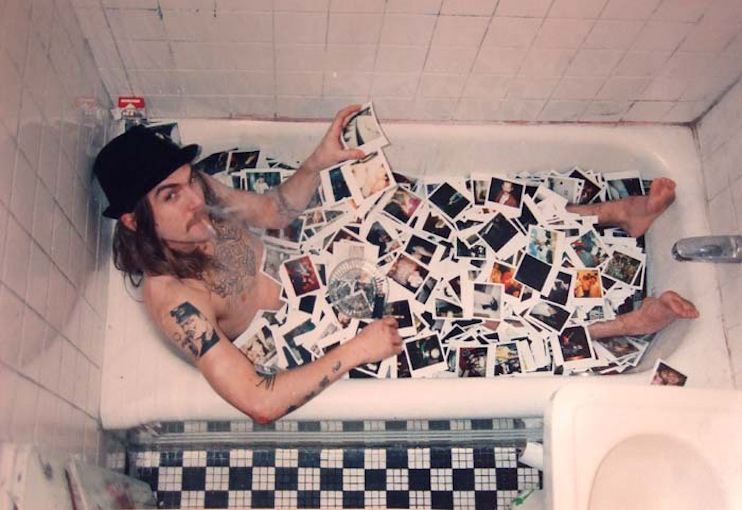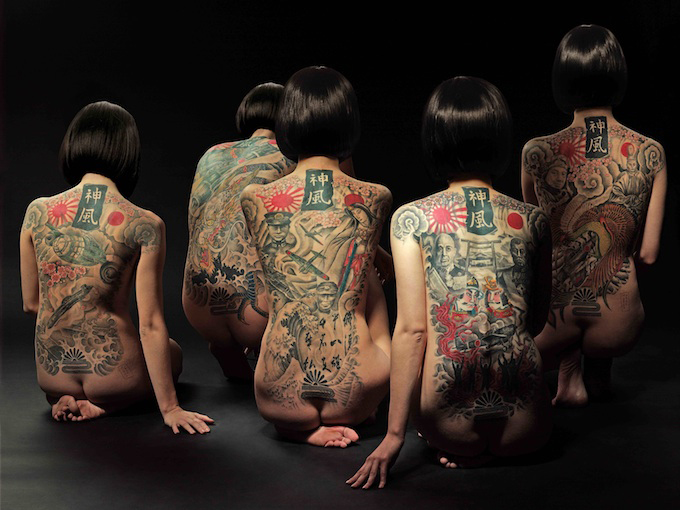The press release for Ascension describes an exhibition where “fragmentation abounds in multitudinous ‘selves’, highlighting large-scale interactions between national and, arguably, mystical realms.”
My impression, however, in moving through the two-level group show was that the artists in the gallery’s meandering lower level were engaged in a more interesting and urgent discussion about a virulent kind of masculinity that is proving to be not just failed but fatal to the long term existence of our species.
The spirit of this debate is embodied, literally, in the works of the Moscow collective, Tanatos Banionis, a commando band of artists/tattooists who employ Japanese warrior lore to illustrate narratives—now permanently etched into the flesh of their models—that detail a militarized movement away from the temporal self toward a more venerated, higher-Eternal Being. Seen historically, this often obligatory journey was best achieved through selfless acts of sacrifice, for country of course, though with grave consequences to what was left smoking in the rear.
It is those consequences that seem to be the real talking point of this exhibition. The idea finds its thesis in Ultra Violet’s printed manifesto, “Killing is the ultimate crime…,” where mid-declarative the question is posed: “Is the membrum virile a tumescent weapon of mass destruction?” The query could easily be a direct response to Tanatos Banionis Divine Wind, a seventeen minute video installation that weaves images of feminine submission with relentless male aggression—the latter in a maniacally ironic nod to honor, duty and lasting glory, with the interim between duty and glory being assuredly terminal.
Exemplar of the heroic arc is the Japanese kamikaze, the renowned and exceedingly feared WWII fighter pilots who time and again gave their lives for country by missiling their planes, and themselves, into enemy warships. But to what end? The Moscow collective’s five large-scale digital prints, all Untitled, suggest instead that what endures is the unconquerable Feminine, in particular an Earth that absorbs and abides until at last it snuffs the annoyance out. In other words, the membrum virile is and will continue to be a singular weapon of destruction that may very well lead us to our doom, but the Earth will journey onward nevertheless, remnants of ourselves left as mere markings on her back.
Symbols of Earth, the women in the five prints similarly submit their backs for engravings not of their own design but for the artistic and political purpose of Tanatos Banionis. In this way they become kamikaze-like in offering forth their flesh for a greater good beyond themselves. On each are inscriptions exclusively of war—samurai, Empire commanders, supplicant infantry in rivers of blood–all sanctioned by the overseeing eye of an Imperial Sun. Meanwhile, our view of the women is always from behind. They do not sanction such action, nor should we infer complicity in their passive stance. As with Earth, theirs is an energy more untamed and lasting, and ultimately far more feral, than the gunshot will of historical man.
This argument is supported in the negative by artists such as Jack Greer and Dave Schubert. Greer’s photographic tryptic, The Incredibles, depicts a Manson-like trio who represent a strain of masculinity gone wholly awry, an assessment that in no way excludes the central figure of a hoodied, silver-toothed woman with “GOD” thickly tattooed onto her forehead. Faint hope that these three will ever act as caretakers of their communities or the planet, though we can be sure they will take freely from both. While Schubert’s C-print blowup of Dash Snow in a tub of polaroids, cigarette at lips, eyes faded to a milky glaze, shows an equally enervate masculinity drained of any ability to nurture or protect. On the contrary, the image speaks of a type of male who offers little more of himself than documents of indulgence, and who will consume to near pathology until all else, though first himself, is gone.
By Christopher Hassett

























